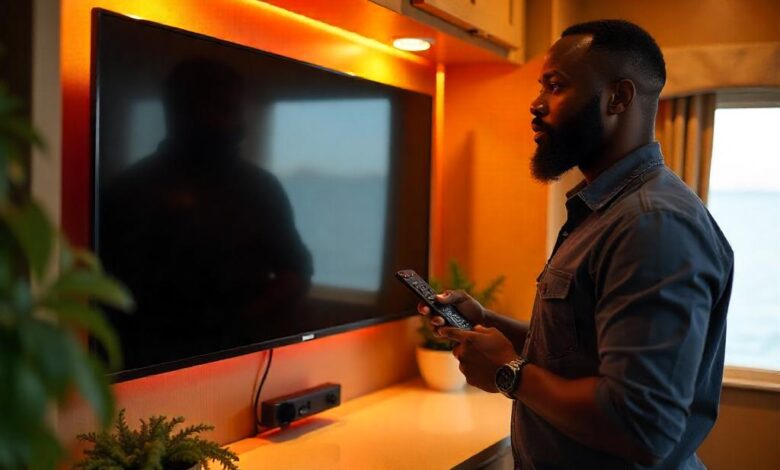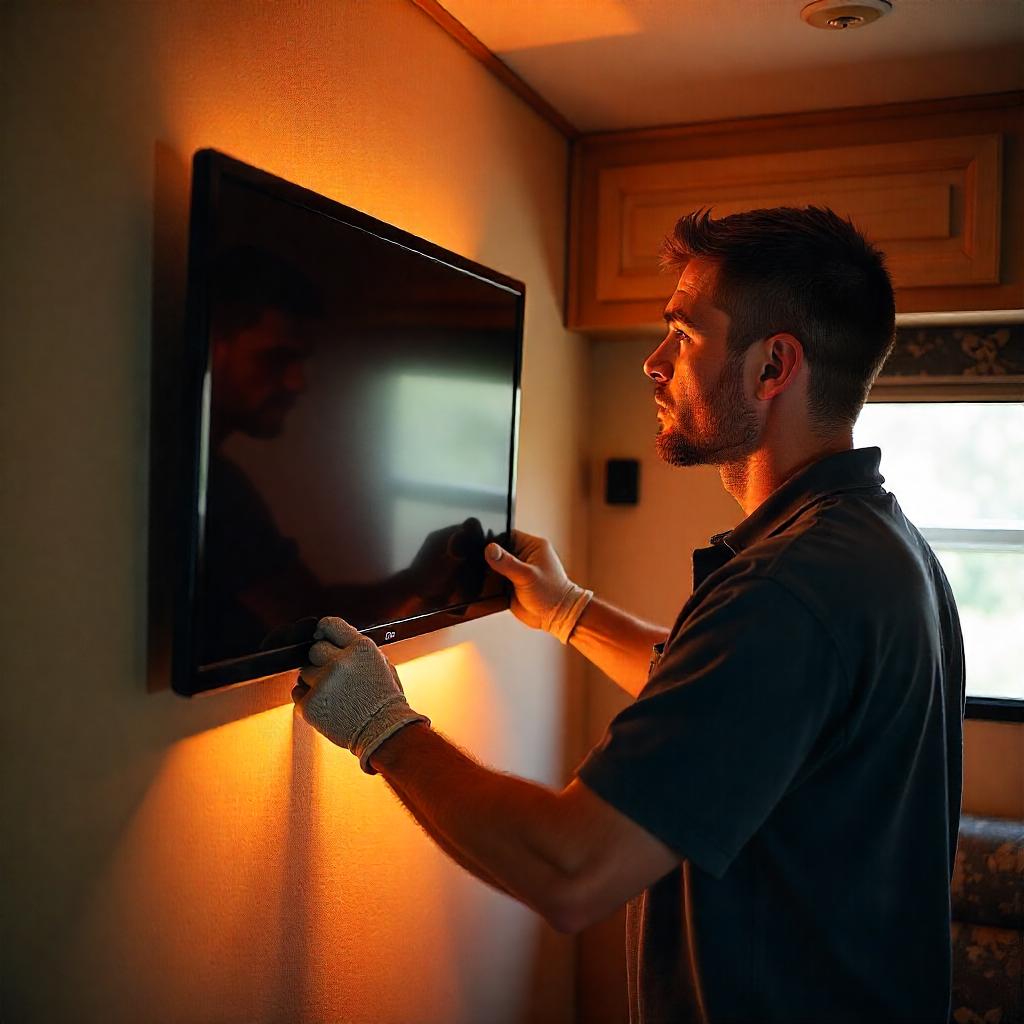How to Mount Tv in Rv without studs?

Table of Contents
How to Mount Tv in Rv without studs?
Mounting a TV in an RV is a common goal for many RV enthusiasts who want the comforts of home while on the road. However, the process is a bit different than mounting a TV in a traditional home. RV walls are typically much thinner and often lack the standard wall studs found in residential construction. This means finding creative yet secure solutions to keep the TV stable, even while traveling over rough terrain. Here, we’ll walk through detailed methods, tools, and insights to make this process easier and safer.
Why Mounting a TV Without Studs is Challenging in an RV?
Mounting a TV in an RV without wall studs can be challenging for several reasons:
- Thin Walls: RV walls are typically constructed using materials such, as plywood or particle board that’re not as sturdy as traditional home walls. As a result of this construction difference, between RV and home walls standard mounting solutions may pose a risk as they may not be able to support the weight of a TV over a period of tim
- Constant Movement: While on the road, RVs are subject to vibration and movement. This adds strain to anything mounted on the walls, increasing the chance of the TV coming loose or the wall suffering damage.
- Limited Support Options: Without traditional studs, RV walls often provide limited support for mounted items, making alternative methods and anchor types necessary.
These factors make it essential to use the right equipment and mounting methods. Let’s explore some practical tools and reliable alternatives that can help ensure a safe and secure installation.
Tools and Supplies Needed for Stud-Free TV Mounting in an RV
Before beginning the installation, it’s essential to gather all necessary tools and supplies to make the process smoother. Here’s a checklist:
- Heavy-Duty Adhesive: Products like industrial-strength Velcro, adhesive tapes, and other heavy-duty adhesives can help hold the TV mount without drilling into the wall.
- Wall Anchors: There are several types of wall anchors designed for use without studs, such as toggle bolts, molly bolts, and expansion anchors, which can distribute weight more effectively.
- Portable TV Mount or Freestanding TV Stand: For those who want an option without any wall mounting, portable or freestanding mounts provide great alternatives.
- Drill and Screwdriver: Necessary for attaching reinforcement plates, wall anchors, and other mounting hardware.
- Reinforcement Plates: Adding reinforcement plates can help disperse weight across a larger surface area, giving more stability to the mounting setup.
- Level and Measuring Tape: Ensures accurate placement and alignment of the TV mount, which helps with viewing angles and overall aesthetics.
Types of Wall Anchors Suitable for RVs
Wall anchors are a game-changer for mounting in RVs without studs. Let’s review the three most effective types:
| Anchor Type | Advantages | Best Used For |
| Toggle Bolts | Strong, holds up to higher weights | Heavier TVs or RVs with thicker walls |
| Molly Bolts | Spreads load, lightweight | Smaller TVs or thin-wall areas |
| Expansion Anchors | Works well on thin materials | Lightweight TVs and small mounts |
Each of these options provides a different level of support, allowing you to match the anchor to your TV’s weight and the RV’s wall thickness.
Choosing the Right Spot for Mounting the TV
Selecting the right location to mount your TV is crucial for both viewing comfort and ensuring that the TV remains securely mounted. To avoid damage or complications, use these guidelines:
- Check for Obstructions: Before drilling or applying adhesive, inspect the wall for any hidden components such as wiring, plumbing, or insulation. These could not only obstruct the installation but also be damaged by drilling.
- Consider Viewing Angle and Distance: Depending on where you’ll typically sit to watch TV, you’ll want to mount the screen at a comfortable viewing height. Typically, mounting at or slightly below eye level offers the best view without neck strain.
- Lighting Conditions: Avoid mounting the TV in a spot with excessive natural light, as it can create glare. Mounting in a shaded corner or a section away from windows can help.
For guidance, here are typical placements in various RV areas:
| RV Area | Recommended TV Placement |
| Main living area | Mounted at eye level for easy viewing while seated |
| Bedroom | Positioned lower, closer to the bed level |
| Kitchen area | Mounted above countertops or in a corner |
Using Adhesive Mounting Solutions in an RV
Heavy-duty adhesives are often the first choice for RVers who want a no-drill solution. These adhesives come in various forms, from double-sided mounting tape to industrial-strength Velcro, and they work well for smaller, lightweight TVs. Here’s a closer look:
Choosing the Right Adhesive for Mounting
- Industrial Velcro: Provides a robust hold for smaller TVs, yet remains easy to remove if you want to reposition the TV later.
- Mounting Tape: Many varieties of heavy-duty mounting tape are designed to support weights up to several pounds. Ensure the tape you choose is rated to handle the weight of your TV.
- Epoxy Glue: An option for those who prefer a more permanent installation; however, it can be difficult to remove.
Safety Tips for Adhesive Mounting in RVs
- Weight Limits: Always check the weight capacity of the adhesive to ensure it’s suitable for your TV size.
- Clean Surface: Adhesives perform best on clean, dust-free surfaces. Wipe down the wall area and the back of the TV before applying.
- Periodic Checks: RV travel can weaken adhesive bonds over time, so check the TV’s stability after each trip.
Heavy-Duty Velcro Strips and Industrial Hook-and-Loop Options
Heavy-duty Velcro strips and industrial hook-and-loop fasteners offer a non-invasive way to secure your TV to an RV wall. These fasteners can support surprisingly heavy weights, making them a popular choice for RV owners.
Benefits of Using Velcro for Mounting TVs in RVs
- No Holes or Drilling: Velcro attaches securely without needing to drill, protecting your RV’s walls.
- Shock Absorption: Velcro fasteners hold up well to vibrations and bumps from road travel, reducing the risk of detachment.
- Easy to Remove: You can easily reposition or take down the TV without damaging the wall.
Best Practices for Installing Velcro or Hook-and-Loop Mounts
- Prepare Surfaces: Clean both the wall and TV for better adhesion.
- Press Firmly: Apply even pressure when attaching Velcro to ensure a secure hold.
- Reapply as Needed: Velcro wears down over time, so replace the strips if they show signs of wear.

Mounting Brackets Designed for Stud-Free RV Installation
If you’re looking for a traditional mounting option, certain brackets are specifically designed for RV use and don’t require studs. Here’s an overview:
Types of Brackets That Work Without Studs
- Low-Profile Mounts: Keep the TV close to the wall, reducing strain and movement.
- Swivel Mounts: Allow angle adjustments, but make sure to support the mount with strong anchors or reinforcement plates to prevent strain.
Installation Tips for Stud-Free Brackets
- Use Extra Supports: Reinforcement plates or additional adhesive tape can help secure the mount to the wall.
- Confirm Placement: Level the bracket to avoid tilt or imbalance.
Read Also : Where to Dump RV Waste for Free Near Me?
Wall Anchors: The Best Options for RV TV Mounting Without Studs
Wall anchors are one of the most reliable ways to mount TVs in RVs without studs. The key is to select the right anchor type and size.
Choosing Wall Anchors Suitable for RVs
- Toggle Bolts: These are perfect for supporting heavy weights and are particularly effective when installed in hollow RV walls.
- Molly Bolts: Provide even weight distribution, making them ideal for thin walls with light to medium weight TVs.
Step-by-Step Installation of Wall Anchors in an RV
- Drill Appropriately-Sized Hole: Ensure the hole is slightly smaller than the anchor’s widest point for a snug fit.
- Insert and Expand the Anchor: Toggle or expand the bolt inside the wall for added stability.
- Attach the TV Bracket: Use screws to connect the TV mount to the anchors.
Securing the TV Mount with Reinforcement Plates
Reinforcement plates distribute weight across a larger area of the wall, adding more security to the installation. Here’s how to use them effectively:
How Reinforcement Plates Work in RV Mounting
- Distributes Weight Evenly: The larger surface area prevents the mount from pulling away from thin walls.
- Reduces Stress: By spreading the load, reinforcement plates protect the wall and mount from strain.
Portable and Freestanding TV Mount Alternatives
For those hesitant about wall mounts, portable or freestanding TV stands provide a viable alternative that requires no drilling or wall installation.
Benefits of Freestanding TV Mounts in RVs
- No Drilling Needed: Avoids potential damage to RV walls.
- Flexibility: Easily repositioned, ideal for different viewing locations.
Choosing the Best Freestanding TV Mount for an RV
Look for stands with non-slip bases and secure clasps to ensure stability on the move.
| Feature | Benefit |
| Non-slip base | Prevents sliding during travel |
| Adjustable height | Allows for custom viewing angles |
| Lightweight | Easy to move to different locations in the RV |
Tips for Testing and Securing TV Stability After Installation

After installation, it’s crucial to test the setup for stability. Here’s a quick guide for ensuring your mount remains secure:
Pre-Travel Checks for Mounted TV Stability
- Tighten Screws and Anchors: Make sure all connections are secure.
- Test for Movement: Gently push on the TV to check for any wobbling.
Maintenance Tips to Keep Mount Secure Over Time
- Regular Inspections: Check for signs of adhesive weakening or wall anchor wear.
- Adjust as Needed: Reapply adhesive, tighten screws, or reinforce as necessary.
Conclusion
Mounting a TV in an RV without studs can be done safely by using adhesive mounts, wall anchors, and other alternative methods. By understanding RV wall structure, selecting the right tools, and following these installation tips, you’ll have a stable TV setup ready for any adventure. Whether you’re using Velcro, portable mounts, or reinforcement plates, choosing a solution that matches your TV’s weight and RV setup will make all the difference.



